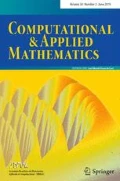Abstract
An algebraic approach for the selection of weight coefficients for weighted moving averaging is proposed in this paper. The algebraic complexity of the sequence transformed by weighted moving averaging is set as a target criterion for the optimization problem of weight coefficients. A special computational setup is constructed in order to tackle the inevitable additive noise for real-world time series. Computational experiments prove that the proposed approach can outperform time series predictors based on classical moving averaging.







Similar content being viewed by others
References
Chen KY (2011) Combining linear and nonlinear model in forecasting tourism demand. Exp Syst Appl 38(8):10368–10376
Dong-xiao N, Hui-feng S, Desheng DW (2012) Short-term load forecasting using bayesian neural networks learned by hybrid monte carlo algorithm. Appl Soft Comput 12(6):1822–1827
Easton JF, Stephens CR, Angelova M (2014) Risk factors and prediction of very short term versus short/intermediate term post-stroke mortality: a data mining approach. Comput Biol Med 54:199–210
Firmino PRA, de Mattos Neto PS, Ferreira TA (2014) Correcting and combining time series forecasters. Neural Netw 50:1–11
Holt CC (2004) Forecasting seasonals and trends by exponentially weighted moving averages. Int J Forecast 20(1):5–10
Hyndman RJ (2012) Time series data library. http://data.is/TSDLdemo. Accessed 16 Jan 2012
Jia C, Wei L, Wang H, Yang J (2014) Study of track irregularity time series calibration and variation pattern at unit section. Comput Intell Neurosci 2014:14. http://dx.doi.org/10.1155/2014/727948
Kurakin V (2001) Linear complexity of polinear sequences. Disctrete Math Appl 11(1):1–51
Kurakin, VL, Kuzmin AVMAS, Nechavev AA (1995) Linear complexity of polinear sequences. J Math Sci 76:2793–2915
Ma R, Hu SJ, Xu HH (2013) Very short-term wind speed prediction of a wind farm based on artificial neural network. Adv Mater Res Trans Tech Publ 608:677–682
Manikandan MS, Soman K (2012) A novel method for detecting R-peaks in electrocardiogram (ECG) signal. Biomed Signal Process Control 7(2):118–128
Nan X, Li Q, Qiu D, Zhao Y, Guo X (2013) Short-term wind speed syntheses correcting forecasting model and its application. Int J Electric Power Energy Syst 49:264–268
Palivonaite R, Ragulskis M (2014) Short-term time series algebraic forecasting with internal smoothing. Neurocomputing 127:161–171
Park H, Elden L (2003) Matrix rank reduction for data analysis and feature extraction. Tech. rep., technical report
Ragulskis M, Lukoseviciute K, Navickas Z, Palivonaite R (2011) Short-term time series forecasting based on the identification of skeleton algebraic sequences. Neurocomputing 74(10):1735–1747
Sauer T, Yorke JA, Casdagli M (1991) J Stat Phys. Embedology 65(3–4):579–616
Starzak ME (1989) Mathematical methods in chemistry and physics. Springer Science & Business Media, Berlin
Trefethen LN (1999) Computation of pseudospectra. Acta Numerica 8:247–295
Wang J, Hu Mm, Ge P, Ren Py, Zhao R (2014) A forecasting model for short term tourist arrival based on the empirical mode decomposition and support vector regression. In: Proceedings of 2013 4th international Asia conference on industrial engineering and management innovation (IEMI2013). Springer, Berlin, pp 1009–1021
Weisstein EW (2015) Logistic map. From MathWorld–a wolfram web resource. http://mathworld.wolfram.com/LogisticMap.html
Wright TG, Trefethen LN (2002) Pseudospectra of rectangular matrices. IMA J Numer Anal 22(4):501–519
Zhang W, Wang J, Wang J, Zhao Z, Tian M (2013) Short-term wind speed forecasting based on a hybrid model. Appl Soft Comput 13(7):3225–3233
Acknowledgments
This work was supported by the Lithuanian Science Council under project No. MIP-078/2015.
Author information
Authors and Affiliations
Corresponding author
Additional information
Communicated by Antonio José Silva Neto.
Rights and permissions
About this article
Cite this article
Landauskas, M., Navickas, Z., Vainoras, A. et al. Weighted moving averaging revisited: an algebraic approach. Comp. Appl. Math. 36, 1545–1558 (2017). https://doi.org/10.1007/s40314-016-0309-9
Received:
Revised:
Accepted:
Published:
Issue Date:
DOI: https://doi.org/10.1007/s40314-016-0309-9




